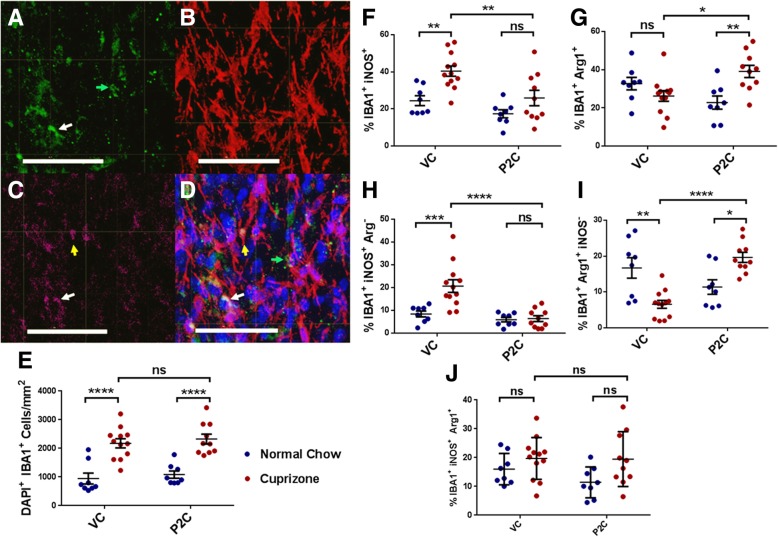Fig. 4.
Effect of TLR2 tolerance induction on microglia frequency and phenotype. a–d overlapping immunohistofluorescent stains of one representative corpus callosum section. a green = Arg1+ cells, b red = IBA1+ cells; c magenta = iNOS+ cells; d all images merged; blue = DAPI. In d, the green arrow depicts the example Arg1+ cell also shown in a, the yellow arrow depicts the example iNOS+ cell also seen in c, and the white arrow depicts the example double-positive, iNOS+Arg1+ cell, also seen in a and c. Scale bars represent 50 μm. e Analysis of IBA1+ cell frequency in corpus callosum sections, based on co-localization of DAPI+ IBA1+ cells. f Percentage of IBA1+ cells that are iNOS+ (total = single and double positives). g Percentage of IBA1+ cells that are Arg1+ (total = single and double positives). h Percentage of IBA1+ cells that are iNOS+ single positive (Arg1−). i Percentage of IBA1+ cells that are Arg1+ single positive (iNOS−). j Percentage of IBA1+ cells that are iNOS+Arg1+ double-positive. Data points represent individually analyzed sections derived from 4 mice per cohort; 2–3 sections were analyzed from each mouse. N = 8–12 total sections per experimental cohort. Error bars represent the mean ± SEM. Statistical differences were assessed by 2-way ANOVA, *p < 0.05; **p < 0.01; ***p < 0.001; ****p < 0.0001. For NS comparisons: e Cuprizone-fed: VC vs P2C, p = 0.9042. f P2C treated: normal vs cuprizone-fed, p = 0.3729. g VC treated: normal vs cuprizone-fed, p = 0.6316. h P2C treated: normal vs cuprizone-fed, p > 0.9999. j VC treated: normal vs cuprizone-fed, p = 0.6881. P2C treated: normal vs cuprizone-fed, p = 0.1123. Cuprizone-fed: VC vs P2C, p = 0.9999

